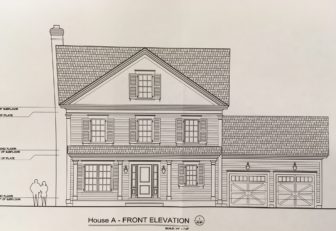Seeking to tweak the New Canaan Zoning Regulations in a way that will make his plans possible, the would-be developer of the Roger Sherman Inn on Monday filed a new application that proposes a so-called “overlay district.”

Rendering of a future Roger Sherman Inn site home.
Filed on behalf of Norwalk developer Andrew Glazer and Glazer Group, the proposed district would allow him to convert part of the existing inn into a residence and build another six 2.5-story, 2,600-square-foot units on the 1.8-acre lot at 195 Oenoke Ridge Road.
Located in the 1-acre zone with a 96-foot easement that runs east of the parcel, the property could accommodate a single home under the existing regulations.
Glazer in an initial application made in September and at a subsequent public hearing last month argued that his plan would bring the property into greater conformity with the regulations because it would be a non-commercial use.
Filed by Westport-based engineering firm Landtech—not by an attorney who specializes in land use matters, as typically is done—the proposed ‘Non-Conforming Residential Overlay District’ “would allow existing non-conforming uses to be replaced by a more conforming uses.”
“The proposed amendment is a precursor to our special permit application for the proposed residential development of the Roger Sherman Inn,” Landtech principal Peter Romano said in the Nov. 14 application.
Specifically, the new overlay zone would apply only to lots of at least 1.5 acres, according to the proposal, that provide frontage on a state highway—in the case of the inn, Route 124—that is “equal to at least 15 percent of the perimeter of the lot or, on the sites over 2 acres, at least 25 lineal feet.”
“The newly created residential use shall not exceed a density of six dwelling units per one acre of land either attached or detached,” the application said.
Other specifications for the proposed zone appear to follow the proposed Roger Sherman Inn project rather closely. For example, the application said, “a building coverage bonus for the newly created Non-Conforming Residential Overlay District shall be allowed.”
“The bonus may not exceed 5 percent of the non-conforming coverage,” it said. “In accordance with Section 3.5.D Coverage the P&Z Commission may example an additional minimal amount of coverage associated with open porches, decks, balconies and other similar open structural projections from building coverage; provided that such open structural projection will benefit safety or convenience or will further the intent to preserve and/or enhance the character and appearance of the residential area.”
The proposal also specified that “Groups of buildings on a single lot shall be so arranged that the minimum horizontal distance between the nearest walls or corners of any principal and/or accessory detached buildings shall not be less than 10 feet.”
The new application follows an initial set of text amendments proposed by Glazer to make his project possible—proposals that raised questions at last month’s hearing. For example, officials said it wasn’t clear how many other commercial properties in town would qualify for the exception that Glazer had proposed—nurseries on Frogtown and Old Stamford Roads being two example.
Glazer has identified himself as “the contract purchaser of the property.” It’s owned by a limited liability company whose principal is Joseph Jaffre of Heritage Hill Road and whose agent is Nesreen Jaffre of Ridgefield, according to tax records and records on file with the Connecticut Secretary of the State. They bought it for $3,415,000 eight years ago, records show.
Several neighbors individually or through an attorney voiced opposition to Glazer’s plan at the hearing.
Additional letters on file at Planning & Zoning express concerns about the project’s density.
One letter from Bill Curren and Cindy MacCollum of Hampton Lane stated that “while we are not opposed to Andy Glazer developing the Roger Sherman Inn into a residential community, we feel the number of units and coverage proposed is too high for the size of the property.”
“We believe that this density is not in keeping with the character of this part of New Canaan,” their letter said. “We would welcome a proposal that would suggest a reduced number of buildings and overall coverage. We are direct neighbors of the proposed development.”
At the October hearing, a representative from the Maples Inn development next door—also a Glazer effort—told P&Z that the residents’ association voted 5-2 in favor of it.
One letter on file appears to come from a Maples Inn unit owner, Jaime Yordan, who opposes the project.
“It is my understanding that the applicant characterizes the proposed development as a reduction in the existing ‘non-conformity’ of the Roger Sherman Inn,” his letter said.
“It is my further understanding that the current non-conformity permits a commercial use (country inn) in a residential zone. I believe what the applicant is proposing is a greater non-conformity in terms of density, use and lot coverage. The applicant is seeking an improper spot zoning which is contrary to the general zoning for the single parcel at 195 Oenoke Ridge Road … I object to the houses being proposed being built alongside the minimum allowed distance to the property line. Both of the density and the location of the houses reduce open space and change the nature and character of the neighborhood. If both of these conditions were to change, I would reconsider my objection to the proposed development.”